Excerpt:
“In the Information Age, the archive performs a unique role in society as a building constructed to house information through the ages. In contemporary culture, it is largely understood as a neutral repository, but notions of power and control are in fact fundamental to its formation and etymology. The term ‘archive’ derives from the Latin ‘archivum’, meaning the ‘residence of the magistrate and those who command’ , which in turn comes from the Greek arkhe, a word that signifies both ‘commencement’ and ‘commandment’. As Derrida noted, it is thus both a principle of nature or history – within which things commence – and a principle of law – within which authority and social order are exercised. It is simultaneously a place – oikos – and a form of order and law – nomos. It refers concurrently to a particular building – typically a symbol of a public institution – and the collection of documents that it houses. If this information is understood as power, the archive is, and has always been, a critical technology of rule.
This history of the archive dates back to early practices of agriculture, within which forms of ‘external memory’ comprised of written documents were employed to keep track of land, production and, eventually, taxes. The ability to write was limited to the elites during this formative period, and therefore the accumulation of early records in storehouses was not innocent. In fact, rulers who were accruing power by controlling resources invented the archive as a means by which to consolidate and reinforce their authority. The Venetians were the first to develop a well-articulated state archival system to this end in the mid-15th century, and used it to expand their commercial maritime empire. But over time, as writing (as well as other mediums) became more accessible and expanded to record more information about ever more topics, such mechanisms proliferated. Today, archives are used not only for research, but also to construct national identities, to retain material about religions, politics, laws and even individual families. The duality of understanding them as spaces and laws, as well as buildings and the information that they contain, intertwines them with complex questions of power that are inherent in the fundamental acts of archiving – selecting, ordering and preserving.”
